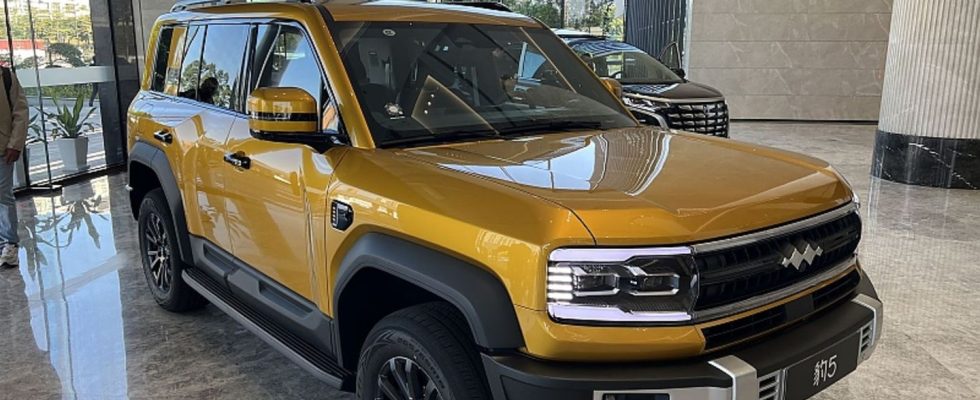Technology: BYD starts technology offensive
A new star
BYD Bao 5
© press-inform – the press office
BYD is setting a breathtaking pace in its electronics and infotainment development. The progress in autonomous driving is also unmistakable.
In China, flowery names are part of the concept. “Xuanji” means “North Star” in German. Actually nothing out of the ordinary, but one or two Teutonic automobile managers will soon get their breakfast cereal stuck in their throats when they hear this term. Because behind this name there is nothing other than part of a technology offensive by the Chinese car manufacturer BYD, which takes infotainment and connectivity up a notch. Of course, not everything that the increasingly self-confident Asians are touting as the latest fashion, “best in class” or “first car manufacturer” is as groundbreaking and unique as the pithy words suggest, but the trend is clear. While the VW Group has difficulties bringing smoothly functioning infotainment into the car with self-written software and has to connect with Google, the Chinese are taking their bits and bytes fate into their own hands.
It is clear to everyone that infotainment is much more than precise navigation maps and a smoothly functioning Bluetooth connection. But BYD shows where the journey is going and that you have to take unconventional paths in order to be successful in the home market. In the Middle Kingdom, your own car is like another living room. Quite a few employees spend their lunch break not in the office with their colleagues, but in their own four metal walls. “The car should be a trusted partner, a friend,” says a BYD engineer. Another phrase from the marketing textbook. This only applies to a limited extent for the Chinese car manufacturer. A smart cockpit should invite you to linger, even when the car is stationary.
If desired, the car can be transformed into a video game console on which the driver can play a racing game. The monitors are big enough and the steering wheel acts as a gamepad. Since the valance is decoupled from the wheels, you can really put your foot down on the virtual Nordschleife. BYD is probably relying on steer-by-wire, where the steering wheel no longer has a steering column anyway. This technology is basically the same as a force feedback steering wheel used in a video game. So the implementation is easier than you think. Monitors of up to 16 inches and a bombastic sound system are part of the interior of the BYD models.
If you prefer to belt out karaoke hits, you can do that too. What makes the inventors at the BYD headquarters tick can be seen in the next feature, which is probably far too playful for most European automobile enthusiasts, but will find its fans in the large Asian country and certainly elsewhere. A drone will soon be on board, which will be launched from the car, follow the car up to a speed of 50 km/h and, if desired, take photos and videos before landing again and being recharged. For this purpose, the Chinese are already working with the renowned drone manufacturer DJI.
The fun ends with autonomous driving anyway. BYD has long since entered the race for the robo-vehicle and is now putting its cards on the table for the first time. The Chinese have not yet reached level 3, as the car drives itself for a maximum of 30 seconds, but the autonomous Denza N7 cuts a good figure on a 19.8-kilometer test lap through Shenzhen, including a city highway. In particular, the vehicle handles merging and avoiding obstacles quite smoothly, i.e. without abrupt braking or jerking off again. The system also slows down sensitively at a red light, similar to a human driver. When a motorized two-wheeler suddenly crosses the road, Auto-Pilot reacts proactively and immediately eases off the accelerator.
Artificial intelligence plays an important role in BYD’s automotive future. “The car should function like the human brain, with different data stored in both halves,” explains the technician, meaning AI that operates in the cloud or in the car. So it’s not a fundamentally new concept, as the vehicle mutates into a rolling high-performance computer anyway. This should provide a response to a voice input within 300 milliseconds. As with Audi and other German manufacturers, a powerful computing unit that collects the messages from the sensors will swing the baton. In addition to the 5G network, which is almost mandatory in China, BYD is also installing a connection to a satellite network.
This technology offensive is accompanied by new cars such as the Bao 5 (an SUV the size of the Land Rover Defender), the Mercedes EQG competitor BYD Yangwang U8 and its hypercar relative BYD Yangwang U9, for which it is not certain when and whether they come to Europe. When it comes to technology features, it’s only a matter of time.

